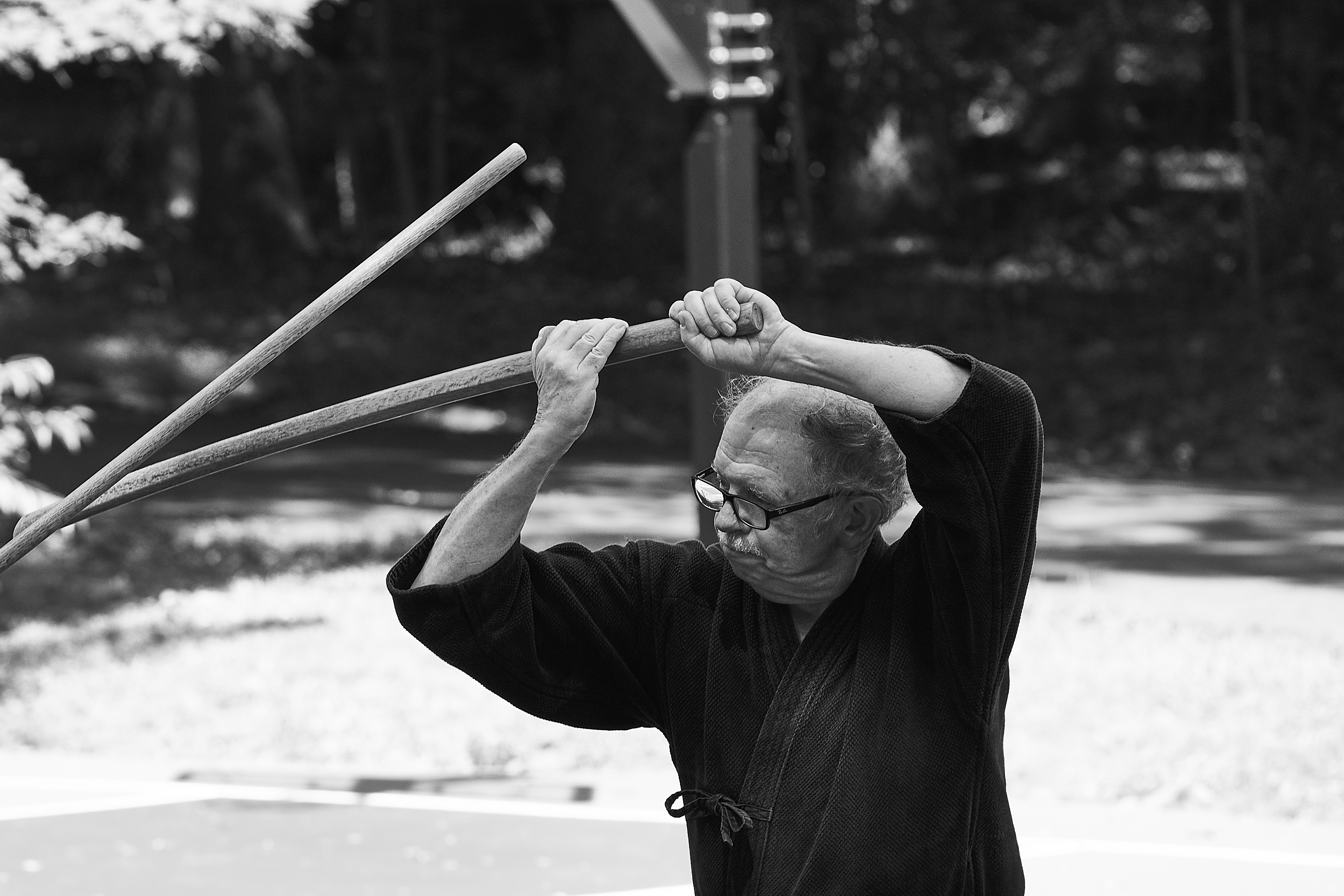Inner Dharma
Selected writing on traditional martial arts and culture.
☰ In Memorium: David A. Hall (1947-2025)
July 2025

On 26 July 2025, the world lost one of its most knowledgeable teachers and scholars of classical Japanese martial culture.
☰ Examples of Psychological Pressure in Jikishinkage-ryū
June 2025
Raito (the variation of jodan no kamae used in Jikishinkage-ryū) is often viewed as a strong offensive kamae, good to attack from. However, in to-no-kata, we actually do not see shidachi using raito to directly attack, except in one introductory kata called menkage. We examine a bit of the structure of to-no-kata to explain why this might be, and the combative initiative involved. We then explore how the practice of kodachi relates to to-no-kata, and how formal kodachi practice can be a point of entry to armed grappling called kogusoku.
☰ Surveying Recent Academic Scholarship on Jikishinkage-ryū
May 2025
Discussing recent scholarship on the early/proto Jikishinkage-ryū kenjutsu of Ogasawara Genshinsai, which he called Shin-no-shinkage heihō, highlighting the influence of Taoism and esoteric Buddhist practice on his swordsmanship.
☰ Kuzushi Example: Enren
February 2025
Kuzushi in my practice of kenjutsu refers to taking apart kata and exploring their meaning and application. It is deeper than simply having a set number of variations or henka. In this essay I describe an example of kuzushi drawn from the last section of Jikishinkage-ryū to-no-kata, called enren.
☰ Gassan Kenpō
December 2024
I provide some information on the organization, goals, and overal training context of my efforts at preserving a practice of Jikishinkage-ryū kenjutsu (heihō) and related arts.
☰ Hōjō ken Kororo-e sho
December 2024
Text on Jikishinkage-ryū Hōjō (foundational) swordsmanship, provided for reference based on Jikishinkage-ryū Sōhonbu and Hōbyōkan material. This is typically chanted or recited before performance of the Hōjō kata of Jikishinkage-ryū.
☰ Japan Pilgrimage
November 2024
Moon Mountain Hall (月山館 ) – read as Gassankan in Japanese and Yueshan-guan in Mandarin – is the name I use for my ongoing training activities. It was chosen in homage to Gassan and Dewa Sanzan, where in 2004 I decided to shift from teaching modern goshin-jutsu to focus on older martial arts.
☰ Divergence and Unification in Shinkage-ryū
September 2024
Link to an essay on kata, heiho and shugyo, where I compare and contrast different surviving lines of Shinkage-ryū and reflect on my own practice.
☰ Tōsha Dōjō (Jiki in Seattle)
August 2024
Lonin League hosts a weekly practice of introductory kata drawn from classical Kashima-shinden Jikishinkage-ryū kenjutsu.
☰ The Opening and Closing of Doors
June 2024
I trained in the art of Kashima-shinden Jikishinkage-ryū at the Hōbyōkan before moving to Seattle in 2016. I then worked with a small number of people in order to maintain my practice. This activity centered around the performance of traditional kata as informed by my understanding of internal martial arts principles, the analysis of kata in a process called kuzushi and pressure testing called tameshi-ai.
☰ General Qi Jiguans's Jixiao Xinshu and Reflections on Claims of Martial Virtue
February 2023
An essay published at Kogen Budo, where I look at some older writings from Japanese koryu that reference classical Chinese military treatises, and then examine how practices described in those works may be represented in arts surviving today.
☰ Gogyō Exegesis
May 2020
An essay describing my experience, thinking, and choices regarding attempting to practice multiple koryū and then deciding not to.
☰ Pressure Testing in Classical Budō
February 2020
A description of some of my efforts to keep my practice of kenjutsu intact after moving to the Pacific Northwest. After moving, I decided to focus solely on Shinkage-ryū and pause my study of Shintō-ryū. I trained initially alone and over time tested my skills in unscripted environments. This is some of what transpired.
☰ 2019 Pittsburgh Taiji Seminar
May 2019
Updates from a seminar in Northern Wu Style Taijiquan with Zhao Zeren and Zhang Yun held in Pittsburgh, PA.
☰ 2017 Taiji Classics Seminar
June 2017
Attending a seminar detailing excerpts from the Taiji classics.
☰ Aiki and Internal Training
February 2017
Collected thoughts on the historical influence of Chinese martial arts on Japanese jujutsu and how they relate to the topic of aiki in Aikido and Daito-ryu. What interested me about internal martial arts and how I have related that experience to my practice of Japanese budō.
☰ 2015 Princeton Bagua and Taiji Seminar
September 2015
At the end of summer, I traveled to Princeton for a seminar in Bagua and Taiji and was accepted as a formal lineal student by my teacher, Zhang Yun. I also traveled to the Pacific Northwest, where I was able to visit with budo colleagues in Oregon.
☰ NAMT Night of Budo 2013 – an analysis
June 2013
A brief reflection on a demonstration of Araki-ryū and Tenshin Buko-ryū at the NAMT 2013 Night of Budo.
☰ NYC Aiki-jujutsu History
October 2012
Collecting what I know of NYC area Aiki-jujutsu schools inspired by the teaching of Daito-ryu Kodokai, especially Yonezawa Katsumi.
☰ Gassankan Jujutsu
October 2008
In Baltimore, after leaving my first dojo in NYC, I continued to work on refining the modern goshin-jutsu護身術 methods I had first learned with my colleague Ben Lawner. The result was a smaller curriculum informed by our practice of Gao lineage bagua.
☰ Three Treasures and Six Harmonies
March 2008
An examination of baguazhang body mechanics compared to modern kempo. A discussion of power generation in internal martial arts. How training in internal martial arts changed my Aikido.
☰ Early Training Influences
January 2005
From 1989 to 2001, while living in New York City, I practiced at an independent Aikido dojo that focused on self-defense methods. I continued this effort after moving, and began training in Gao Lineage Bagua in 2004.